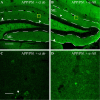Abeta immunotherapy protects morphology and survival of adult-born neurons in doubly transgenic APP/PS1 mice
- PMID: 19906959
- PMCID: PMC6665051
- DOI: 10.1523/JNEUROSCI.2055-09.2009
Abeta immunotherapy protects morphology and survival of adult-born neurons in doubly transgenic APP/PS1 mice
Abstract
The hippocampus is heavily affected by progressive neurodegeneration and beta-amyloid pathology in Alzheimer's disease (AD). The hippocampus is also one of the few brain regions that generate new neurons throughout adulthood. Because hippocampal neurogenesis is regulated by both endogenous and environmental factors, we determined whether it benefits from therapeutic reduction of beta-amyloid peptide (Abeta)-related toxicity induced by passive Abeta immunotherapy. Abeta immunotherapy of 8-9-month-old mice expressing familial AD-causing mutations in the amyloid precursor protein and presenilin-1 genes with an antibody against Abeta decreased compact beta-amyloid plaque burden and promoted survival of newly born neurons in the hippocampal dentate gyrus. As these neurons matured, they exhibited longer dendrites with more complex arborization compared with newly born neurons in control-treated transgenic littermates. The newly born neurons showed signs of functional integration indicated by expression of the immediate-early gene Zif268 in response to exposure to a novel object. Abeta immunotherapy was associated with higher numbers of synaptophysin-positive synaptic boutons. Labeling dividing progenitor cells with a retroviral vector encoding green fluorescent protein (GFP) showed that Abeta immunotherapy restored the impaired dendritic branching, as well as the density of dendritic spines in new mature neurons. The presence of cellular prion protein (PrP(c)) on the dendrites of the GFP(+) newly born neurons is compatible with a putative role of PrP(c) in mediating Abeta-related toxicity in these cells. In addition, passive Abeta immunotherapy was accompanied by increased angiogenesis. Our data establish that passive Abeta immunotherapy can restore the morphological maturation of the newly formed neurons in the adult hippocampus and promote angiogenesis. These findings provide evidence for a role of Abeta immunotherapy in stimulating neurogenesis and angiogenesis in transgenic mouse models of AD, and they suggest the possibility that Abeta immunotherapy can recover neuronal and vascular functions in brains with beta-amyloidosis.
Figures







Similar articles
-
Pyroglutamate Abeta pathology in APP/PS1KI mice, sporadic and familial Alzheimer's disease cases.J Neural Transm (Vienna). 2010 Jan;117(1):85-96. doi: 10.1007/s00702-009-0314-x. Epub 2009 Oct 13. J Neural Transm (Vienna). 2010. PMID: 19823761 Free PMC article.
-
An effector-reduced anti-β-amyloid (Aβ) antibody with unique aβ binding properties promotes neuroprotection and glial engulfment of Aβ.J Neurosci. 2012 Jul 11;32(28):9677-89. doi: 10.1523/JNEUROSCI.4742-11.2012. J Neurosci. 2012. PMID: 22787053 Free PMC article. Clinical Trial.
-
Increased hippocampal neurogenesis in the progressive stage of Alzheimer's disease phenotype in an APP/PS1 double transgenic mouse model.Hippocampus. 2009 Dec;19(12):1247-53. doi: 10.1002/hipo.20587. Hippocampus. 2009. PMID: 19309037
-
APP transgenic modeling of Alzheimer's disease: mechanisms of neurodegeneration and aberrant neurogenesis.Brain Struct Funct. 2010 Mar;214(2-3):111-26. doi: 10.1007/s00429-009-0232-6. Epub 2009 Nov 29. Brain Struct Funct. 2010. PMID: 20091183 Free PMC article. Review.
-
Amyloid-beta immunotherapy for Alzheimer's disease.CNS Neurol Disord Drug Targets. 2010 Apr;9(2):197-206. doi: 10.2174/187152710791012017. CNS Neurol Disord Drug Targets. 2010. PMID: 20205640 Free PMC article. Review.
Cited by
-
Vitamin D Improves Neurogenesis and Cognition in a Mouse Model of Alzheimer's Disease.Mol Neurobiol. 2018 Aug;55(8):6463-6479. doi: 10.1007/s12035-017-0839-1. Epub 2018 Jan 9. Mol Neurobiol. 2018. PMID: 29318446 Free PMC article.
-
The Ever-Changing Morphology of Hippocampal Granule Neurons in Physiology and Pathology.Front Neurosci. 2016 Jan 19;9:526. doi: 10.3389/fnins.2015.00526. eCollection 2015. Front Neurosci. 2016. PMID: 26834550 Free PMC article.
-
Combination therapy prevents amyloid-dependent and -independent structural changes.Neurobiol Aging. 2012 Jul;33(7):1273-83. doi: 10.1016/j.neurobiolaging.2010.12.007. Epub 2011 Jan 22. Neurobiol Aging. 2012. PMID: 21257234 Free PMC article.
-
Impaired orthotopic glioma growth and vascularization in transgenic mouse models of Alzheimer's disease.J Neurosci. 2010 Aug 25;30(34):11251-8. doi: 10.1523/JNEUROSCI.2586-10.2010. J Neurosci. 2010. PMID: 20739545 Free PMC article.
-
Effects of Neurotrophic Support and Amyloid-Targeted Combined Therapy on Adult Hippocampal Neurogenesis in a Transgenic Model of Alzheimer's Disease.PLoS One. 2016 Oct 21;11(10):e0165393. doi: 10.1371/journal.pone.0165393. eCollection 2016. PLoS One. 2016. PMID: 27768761 Free PMC article.
References
-
- Abdipranoto A, Wu S, Stayte S, Vissel B. The role of neurogenesis in neurodegenerative diseases and its implications for therapeutic development. CNS Neurol Disord Drug Targets. 2008;7:187–210. - PubMed
-
- Altman J, Das GD. Autoradiographic and histological evidence of postnatal hippocampal neurogenesis in rats. J Comp Neurol. 1965;124:319–335. - PubMed
-
- Arvidsson A, Collin T, Kirik D, Kokaia Z, Lindvall O. Neuronal replacement from endogenous precursors in the adult brain after stroke. Nat Med. 2002;8:963–970. - PubMed
-
- Bard F, Cannon C, Barbour R, Burke RL, Games D, Grajeda H, Guido T, Hu K, Huang J, Johnson-Wood K, Khan K, Kholodenko D, Lee M, Lieberburg I, Motter R, Nguyen M, Soriano F, Vasquez N, Weiss K, Welch B, Seubert P, Schenk D, Yednock T. Peripherally administered antibodies against amyloid β-peptide enter the central nervous system and reduce pathology in a mouse model of Alzheimer disease. Nat Med. 2000;6:916–919. - PubMed
Publication types
MeSH terms
Substances
LinkOut - more resources
Full Text Sources
Other Literature Sources
Medical
Research Materials
